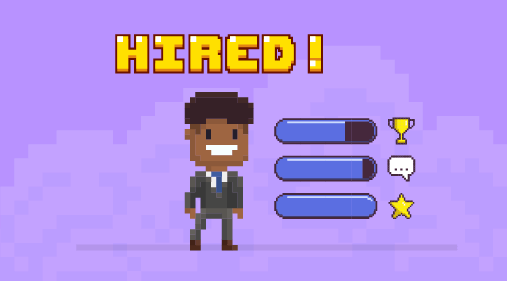Gamification in recruiting: How and why to give it a shot

{first 10-digit prime found in consecutive digits e}.com
This, Google’s famous billboard mathematical riddle, is a sensational example of how useful gamification in recruiting can be. In 2004, Google invited people to solve a series of equations thinking – correctly – that those who had the brains and the motivation to reach the end would make great candidates. Both parties would benefit from this: candidates would enjoy the game and maybe land a job, while Google would easily attract pre-screened, high-quality applicants.
Though not always producing such a buzz, many other companies have experimented with adding games as part of their hiring process to give candidates an opportunity to prove their mettle. The whole concept of gamification in the workplace (applying game elements to business processes) isn’t new: it has been a popular hype for 20 years. Despite some predicting that most gamification strategies would fail, the global industry value was estimated at $4.91 billion in 2016 and it’s expected to rise to almost $12 billion by 2020.
To help you get inspired for your own gamification efforts, we look into the mechanics of gamification in recruitment and dig into some actual results.
Contents
The variety of games
Gamification in recruiting doesn’t refer to one single type of game. Google used a public riddle to attract candidates, but the game could also be an online quiz or a challenge, such as the coding tests offered by companies like Workable’s partner HackerRank and Codility (where candidates solve online programming exercises).
Companies can also use online puzzle or platform games. For example, benchmark.games has developed puzzle games, one of which involves the candidates “navigating a car to reach a goal, while facing unexpected challenges.” (More on benchmark.games and their effectiveness later).
Simulation assessments could also count as ‘fun recruitment games’ – for example, using a service like HR Avatar that gives candidates scenarios to handle (such as difficult customers).
Also, online games are common, but there are other great ideas to gamify your process. Lee-Anne Edwards, CEO and founder of recruiting firm Oneinamil, says she has been experimenting with escapology through Amplified Workforce out of Columbia, S.C.:
Everybody’s tired of the old hiring process, so we’re looking for creative ways to match candidates with jobs. I have started experimenting during the interview process by inviting candidates to spend some time in a room, working together to solve a mystery or puzzle. An interviewer will observe them and make notes on how they work with each other, how they handle the situation and, of course, whether they can provide solutions. I am hoping to observe for teamwork, problem-solving skills and intellectual curiosity. We’ll see how this eventually works out, but I’m super optimistic.
Same game, different hiring stages
To start using gamification in hiring, determine at what stage you’ll ask candidates to play games. Usually, gamification will be more useful in the ‘job application’ and ‘assessment’ hiring stages.
Games can replace application forms
Instead of asking candidates to upload their resume and their cover letter and answer a bunch of qualifying questions, you could ask them to play a game. This has several advantages:
- Those candidates who complete the game are clearly the most motivated. Job seekers probably send a lot of applications – sometimes without doing much thinking on whether they actually like the job or company. Playing a game requires effort and commitment, forcing them to stop and think whether it’s worth their time. Candidates who are less interested might self-select out, so you’ll end up with more relevant applications.
- You can more easily evaluate people without much experience. For example, imagine that you’re hiring for entry-level salespeople and you receive dozens (maybe hundreds) of resumes of recent graduates. Resumes don’t give you much to go on, so you might unwittingly reject candidates who have high potential. But, by asking them to play a game, you can identify their actual skills and abilities early on.
- You can evaluate people who have diverse experience. If you’re evaluating candidates based on their relevant experience, then you might be excluding those who’re making a career or industry change. These people may have different experience but they might also possess transferable skills and the ability to adapt. Games give them the chance to showcase their actual competencies and their agility.
- You can engage candidates. Gamification in recruiting makes your hiring process more interactive and it may also project a company culture that’s enjoyable and fun, thus attracting more quality candidates. There’s a pitfall here: candidates may wonder whether games are effective hiring criteria. You could remove doubts by clearly explaining the purpose of the game and next steps. This means you should be certain that you’ve chosen the right game to assess the right skills – if you’re using a gamification vendor, make sure to ask them how they correlate the game with the skills it assesses (e.g. how a particular game assesses analytical thinking.)
Games can help you evaluate candidates
Games could complement (or even replace) the assessment stage. Instead of asking candidates to complete assignments or answer multiple test questions, you can ask them to play an online game for a few minutes. These games can:
- Help you build diverse teams. Games are the same for everybody and they evaluate specific job-related skills. This means that they can help you screen candidates more objectively than pre-employment tests (such as personality tests) which can disadvantage many people (e.g. introverts) and whose ability to predict job performance is dubious.
- Reduce time to hire. Tests or assignments take several days for candidates to complete and you should also factor in lost time from back-and-forth emails for clarifications. Conversely, a game takes only minutes to play and the results are sent automatically. Reduced time to hire is also an advantage of using games in the application phase – you screen candidates immediately in a fun way instead of shortlisting candidates and screening them later.
Great, but do games really work?
To determine whether gamification in recruiting works, let’s turn to companies who’ve already been seeing results. I recently spoke with David Szilagyi, Founder and CEO of benchmark.games, a company that creates games to help their customers hire better (full disclosure: Benchmark will be a Workable partner soon! Stay tuned for more details on our integration.) David explains what his company does:
Benchmark.games helps companies identify the best candidates for each position, automatically. We have built online games for behavioral pattern analysis that may be customized according to customers’ needs. We ask the company’s high performers to play the game. Then we use their game results to develop predictive models that reveal which candidates will be high performers. That way, hiring managers can quickly see a short list of candidates who matched the high performers’ results and are therefore more likely to become high performers themselves.
One of their biggest customers is Magyar Telekom in Hungary, a subsidiary of Deutsche Telekom (Deutsche Telekom is also the parent company of T-Mobile USA). Telekom used gamification to attract millennials (or candidates with limited work experience) for sales roles. These candidates usually don’t have much experience so their resumes couldn’t showcase their abilities. By removing resumes as a screening factor and adding games, Telekom evaluated candidates’ competencies such as goal orientation, endurance and problem-solving skills.
“In fact, Telekom noticed that some people who had been rejected because of their resumes were hired a year after because they scored really high in our games,” says David. “And now they’re high performers.”
David also highlights reduced time to hire and effectiveness of selecting high performers as important benefits of what his company offers: “Telekom has been a partner of Benchmark for more than 18 months and have found that candidates who have been hired through our games have reached 95% of the KPI levels of high performers just after three months.”
Choose games and vendors wisely
Apart from the ease of use and the entertainment value of the game, its effectiveness depends on how valid it is. Games need to have been developed with the help of extensive research (and a lot of behavioral science), so it’s best to look for companies that specialize in gamification in recruiting. When evaluating vendors, use this checklist to help you make your decision:
- There’s solid research behind their games.
- They keep improving their product via new data and methods.
- They can showcase results from existing customers.
- Their games are uncomplicated and easy to understand.
- The design of their games is attractive.
- They have a clear strategy about how their games can be used.
- Their price is within the budget you’re willing to allocate.
Whatever vendors you choose, don’t be afraid to make your hiring process more fun and engaging. If you select games carefully, you have more chances of evaluating candidates faster and better. Let the games begin!
Frequently asked questions
- How do you gamify recruiting?
- A great way to incorporate gamification into recruitment practices is by having candidates play a game. Instead of just gathering qualifications and personal data, ask the person for their preferences on how you want them vetted so they can best represent your company in an interview setting with other potential hires.
- How is gamification used to recruit potential employees?
- Casual game playing is a great way to engage your future employees. By implementing gamification in the recruiting process, you can make it more interactive and enjoyable while also projecting an attractive company culture, which might attract even better candidates.
- How does gamification help in HR?
- Gamification in HR is an engaging, creative way to get your employees engaged and productive. By implementing gamification into work cultures, you will also be cultivating a fun environment that keeps the best talent around!




